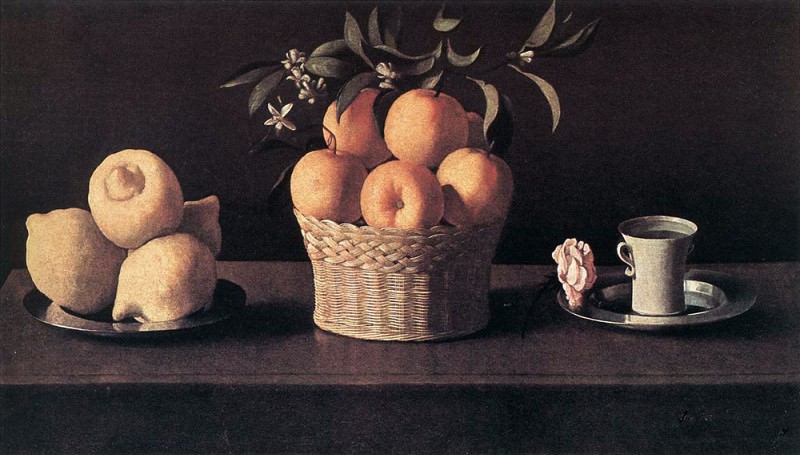Still life with Lemons Oranges and Rose WGA Francisco De Zurbaran
Francisco De Zurbaran – Still life with Lemons Oranges and Rose WGA
Edit attribution
Download full size: 1000×568 px (0,1 Mb)
Back to album: Francisco De Zurbaran
"Still Life with Lemons and Oranges" was painted in 1633 by Francisco de Zurbarán. Much of his collection of paintings is devoted to scenes of monastic life; his favorite genre was still life. In this style of painting one can clearly see the unique ability of the Spanish artist to see in the prose of life the significant and sublime, a deep interest and affection for the land and things around him.
Description of the painting "Still Life with Lemons and Oranges" by Francisco de Zurbarán
"Still Life with Lemons and Oranges" was painted in 1633 by Francisco de Zurbarán. Much of his collection of paintings is devoted to scenes of monastic life; his favorite genre was still life.
In this style of painting one can clearly see the unique ability of the Spanish artist to see in the prose of life the significant and sublime, a deep interest and affection for the land and things around him. The still lifes are filled with stark conciseness and astonishing harmony, giving ordinary things power and solemnity.
The still life under consideration consists of three groups of objects - lemons in a plate, oranges in a small basket, and an elegant cup on a saucer with a rose. Their strict order, lined up in a single line, is one of the distinctive features of Surbaran’s writing style. Thanks to this technique, he achieves three-dimensionality and forces to pay attention to each object of the composition. Another important role is played by the play of light and shadows. With the help of bright color contrasts are conveyed volume and colorfulness.
Much to the surprise of many experts see in this picture an allegorical version of the visualization of the image of the Holy Trinity. The oranges and water in the mug are associated with the innocence of the Blessed Virgin, while the rose, devoid of thorns, is a symbol of the Immaculate Conception. The rose is a symbol of the Immaculate Conception. This theory is quite valid, given Francisco de Zurbarán’s religious upbringing. Other unusual nuances can be traced in the history of the painting.
For example, contrary to the title, it does not show lemons, but citrons, which differ from the former in their dense, lumpy skin and large size. An unexpected discovery after one of the radiographs of the image was the presence of another saucer at an early stage of the work. It was to stand between the citrons and oranges, and was filled with pieces of potatoes in caramel, the traditional dessert of those times.
Кому понравилось
Пожалуйста, подождите
На эту операцию может потребоваться несколько секунд.
Информация появится в новом окне,
если открытие новых окон не запрещено в настройках вашего браузера.
You need to login
Для работы с коллекциями – пожалуйста, войдите в аккаунт (open in new window).











![Francisco De Zurbaran - St. Francis [School]](http://cdn.gallerix.asia/j/Z/100406879/846.webp)
![Francisco De Zurbaran - The Eucharist [Workshop]](http://cdn.gallerix.asia/j/Z/100406879/692.webp)







You cannot comment Why?
Perhaps it’s a painting of a basket of fruit sitting on a table next to a cup and saucer with a saucer and saucer next to it.